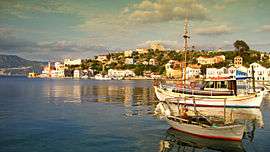Kastellorizo
| Kastellorizo Καστελλόριζο | ||
|---|---|---|
|
View of Kastellorizo | ||
| ||
 Kastellorizo | ||
|
Location within the region 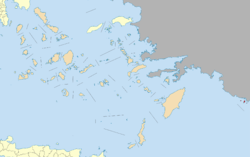 | ||
| Coordinates: 36°9′N 29°35′E / 36.150°N 29.583°ECoordinates: 36°9′N 29°35′E / 36.150°N 29.583°E | ||
| Country | Greece | |
| Administrative region | South Aegean | |
| Regional unit | Rhodes | |
| Area | ||
| • Municipality | 11.987 km2 (4.628 sq mi) | |
| Highest elevation | 273 m (896 ft) | |
| Lowest elevation | 0 m (0 ft) | |
| Population (2011)[1] | ||
| • Municipality | 492 | |
| • Municipality density | 41/km2 (110/sq mi) | |
| Time zone | EET (UTC+2) | |
| • Summer (DST) | EEST (UTC+3) | |
| Postal code | 851 11 | |
| Area code(s) | 22460 | |
| Vehicle registration | ΚΧ, ΡΟ, PK | |
| Website | www.megisti.gr | |
Kastellorizo or Castellorizo (Greek: Καστελλόριζο - Kastellorizo, officially Μεγίστη - Megísti or Meyísti) is a Greek island and municipality located in the southeastern Mediterranean.[2] It lies roughly 2 kilometres (1 mile) off the south coast of Turkey, about 570 km (354 mi) southeast of Athens and 125 km (78 mi) east of Rhodes, almost halfway between Rhodes and Antalya and 280 km (170 mi) to Cyprus.[2] Kastellorizo is part of the Rhodes regional unit.[3]
The island has become more popular in recent years, among tourists looking for an isolated place in the Dodecanese, thanks also to the 1991 Oscar-winning movie Mediterraneo, by Gabriele Salvatores, which is set on the island during the Second World War.
Name and etymology
The island's official name, Megisti (Μεγίστη) means "biggest" or "greatest", but at only 11.987 km2 (4.628 sq mi) in area, it is the smallest of the Dodecanese. The name, however, refers to the fact that it is the largest of the small archipelago.[2] This name was used in antiquity,[4] but is now rarely used in Greek, the name Kastellórizo (Καστελλόριζο) being common since the twelfth century. There are several hypotheses about the origin of this name.[5] "Kastello" derives from the Italian word "castello", meaning "castle".[5] There is some argument on the second part of the name. The arguments are centered on the following possible origins of the element rizo:
- rizo being derived from the Italian word "rosso" meaning "red", either from the reddish color of the rocks of the island, or from the reddish color of the castle at sunset,[5] or from the color of the coat of arms of the Great Master of the Knights of Rhodes, Juan Fernandez de Heredia, which stood above the gate of the castle; these arguments are widely discredited as the rocks on the island do not contain any red pigment and the name Kastellorizo predates the arrival of the Knights.[2]
- rizo being a corruption of the word "Rhoge", one of the ancient appellations of the nearby island of Ro. If this is correct, the island's modern name is actually an amalgam of the separate island names "Castello" and "Rhoge".
- rizo being the actual Greek word "rizon" meaning "root", as researched by Greek Historian I.M. Hatzifotis (1996), to signify the foothill or 'rizovouno' on which the island's original castle was built.[5]
It has gone by several different names in its history, including Kastellorizo (Greek), Castellorizo (Greek name with Italian spelling), Castelrosso (Italian, meaning "Red Castle"), Château Rouge (French translation of Italian name) and Turkish: Meis or Kızılhisar, the former deriving from the island's official name in Greek, the latter meaning "Red Castle", a translation of the Italian name.
Geography
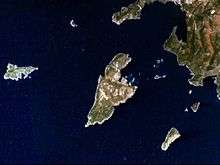
Kastellorizo is (with the exception of the nearby islet of Strongyli) the easternmost Greek island and is situated in the Eastern Mediterranean. It lies about 2 km (1 mi) from the Anatolian coastal town of Kaş, more or less halfway between Rhodes and Antalya. Cyprus is about 280 km (170 mi) to the south-east. It is six kilometres (3.7 miles) long and three kilometres (1.9 miles) wide, with a surface of 9.2 square kilometres (3.6 sq mi). It has a triangular shape, and is oriented from NE to SW. The island features three capes: Agios Stefanos (north), Nifti (east) and Pounenti (south west); between the first two there is a wide and accommodating bay, the island's main harbor, where one finds the only town on the island. Cape Agios Stefanos, the nearest to Anatolia, is 2250m south of the modern Turkish town of Kaş (Greek: Andífli, the Ancient Greek City of Antiphéllos). Cape Nifti lies some greater distance from the Anatolian coast. The island is mountainous, with high and steep coastlines, which become more difficult to access moving west. The soil is composed of limestone, and produces only small amounts of olives, grapes and beans. On the island there is no source of drinking water. The Municipality of Megísti includes the offshore islands of Ro and Strongyli as well as several smaller islets. It has a total land area of 11.987 square kilometres (4.628 sq mi).
Climate
| Climate data for Kastellorizo, Greece | |||||||||||||
|---|---|---|---|---|---|---|---|---|---|---|---|---|---|
| Month | Jan | Feb | Mar | Apr | May | Jun | Jul | Aug | Sep | Oct | Nov | Dec | Year |
| Average high °F (°C) | 59 (15) |
60 (16) |
65 (18) |
71 (22) |
80 (27) |
89 (32) |
94 (34) |
94 (34) |
88 (31) |
81 (27) |
70 (21) |
62 (17) |
76.083 (24.491) |
| Average low °F (°C) | 41 (5) |
42 (6) |
46 (8) |
51 (11) |
59 (15) |
67 (19) |
73 (23) |
73 (23) |
66 (19) |
59 (15) |
50 (10) |
44 (7) |
55.916 (13.287) |
Source: <World Weather Online= >Kastellorizo Island Public Airport (kzs) Monthly Climate Average, Megísti. World Weather Online. 2016 http://us.worldweatheronline.com/v2/weather-averages.aspx?q=kzs. Retrieved 12 September 2016. Missing or empty |title= (help) | |||||||||||||
Geology
The island's geology is almost exclusively limestone laid down at the Mesozoic/Cenozoic boundary. As a result of the lack of significant flora covering the island, the landscape shows many features of karstification. There are a number of notable sea caves including the so-called Blue Grotto which is much larger than its namesake in Capri. Exploration undertaken in 2006 by members of the SELAS Caving club of Greece has revealed vertical caves in many parts of the island. The deepest found so far was surveyed to a depth of 60 metres (200 ft) in March 2006 and will be the subject of further exploration in the future by the same team.

Description of the island
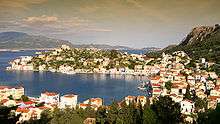
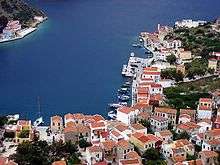
The houses of the town are slender and characterised by wooden balconies and windows of the Anatolian type.[6] Behind the waterfront, many houses are still in a ruinous state. At the entrance to the harbour, on the east side, stand the single story remnants of the former Italian government house (palazzina della delegazione), erected in 1926 by the Italian architect Florestano Di Fausto, who also designed some of the most important buildings of the Italian period in Rhodes.[7] Nearby is the island's former Ottoman mosque which dates from the second half of the 18th century and which has been restored and re-opened as a museum since 2007. From here starts the town's quay, which runs along all three sides of the harbour. The central square —Plateia Ethelondon Kastellórizou ("Kastellorizo Volunteers' Square")—lies at the midpoint of the eastern side, near the vessel dock. On the opposite side of the harbour one has a good view from this vantage of Pera Meria, the western quay, and the monasteries of Profitis Ilías and Aghia Triadha, the former now an army base.
Above the quay on the eastern side there is a pathway which leads to the Castle of the Knights (14th century). Of it remain the curtain wall, part of a square tower, the remains of a cylindrical tower at the east corner, and toward the sea another cylindrical tower.[8] A Doric inscription, carved in the rock, attests to the existence of an earlier fortress here during Antiquity.[8] Inside the tower there is a large covered cistern.[8]
Ascending the steps on the eastern side of the town, one reaches the suburb of Horafia, where there is a square surrounded by the Church of St. George (1906), with a high dome of Byzantine type, and the Cathedral of Saints Constantine and Helena (1835). It has three naves divided by monolithic granite columns from the temple of Apollo Lykios in Patara (Anatolia).[6] The columns carry ogival arches. Further east is the small bay known as Mandraki, the secondary harbour of the island.
West of the town, beyond the summit of the island known as Vigla (270 m), stands Palaiokastro (old castle), the island's ancient acropolis. This fortified elevation has classical origins (see below, history section): its plan is rectangular and measures 60 by 80 metres (200 ft × 260 ft). In its interior stand an ancient tower, built with square limestone blocks, and large water cisterns. Carved on the base of the castle there is also a Doric inscription, dating back to the 4th or 3rd centuries BC, with references to Megiste (the ancient name of Kastellorizo) and its dependence on Rhodes. On the east side there are remnants of a gateway, or propylaea.
Transport
The island is connected with Rhodes, Piraeus and Kaş by ferry. Passenger ferries' frequency is as follows:
- Kastellorizo - Rhodes - Symi - Tilos - Nisyros - Kalymnos - Piraeus : 2 trips / week (winter period)[9]
- Kastellorizo - Kaş : 1 trip / week (winter period)[10]
Air connection is provided by Olympic Air, which operates from Kastellorizo Airport 4 times/week (winter period).[11] There is one small bus in service on Kastellorizo and it is used to collect tourists from the airport.
Archipelago between Turkey and Kastellorizo
There are many islets in this area; Volos, near Kalkan (in Greek Kalamaki), Ochendra, Furnachia, Prassonisi, Ro, Tragonera, Marathi, Strongyli, Dhassia, Alimentaria, Kekova, besides many rocks and cliffs.[8] The most important among these islets is Kekova (also named Caravola), not inhabited, which has an area of 4.5 square kilometres (1.7 sq mi) and faces the Turkish village of Kaleköy (Simena in antiquity). All these islets were subject to dispute between Italy and Turkey until 1932. According to 1932 Convention between Italy and Turkey all these islets - with the exception of Ro and Strongyli - were assigned to Turkey.
History
The island was colonised by Dorian Greeks, who named it Megiste.[12] Inscriptions found at the foot of the Knight's castle confirm that during the Hellenistic period the island was ruled by Rhodes, and formed part of its Peraia. The Rhodians sent an overseer, or epistates, to monitor events on the island.

During the period of the Byzantine Empire, Kastellorizo was part of the 'Eparchy of the Islands', the capital of which was Rhodes. In 1306 the island was taken over by the Knights of St. John Hospitaller of Jerusalem, headed by Folques de Villaret.[2] They were on their way from Cyprus to Rhodes, which was conquered three years later, becoming the centre of their Crusader State. They restored the castle, which was thereafter used as prison for disobedient knights. Around 1440 the island was occupied by Sultan Djemal-el-din Yusuf of Egypt, who destroyed the castle.[2] Ten years later it was conquered by Alfonso V of Aragon, king of Naples, who in 1461 rebuilt the castle and dispatched a governor. Naples retained possession of it until 1512, when it was conquered by Ottoman Sultan Suleiman I.[2]
On 22 September 1659, during the war over Crete, the island was conquered by Venice and the castle was destroyed again, but the Ottomans were able to regain it again soon after.[2] Between 1828 and 1833 Kastellórizo joined the Greek insurgents, but after the end of the Greek War of Independence it came back in possession of the Ottoman Empire.[2]
In 1912, during the Libyan war between Italy and the Ottoman Empire, the inhabitants asked Giovanni Battista Ameglio, chief of the Italian occupation forces in Rhodes, for their island to be annexed to Italy. This was refused, and on 14 March 1913 the local population imprisoned the Turkish governor and his Ottoman garrison and proclaimed a provisional government.[7] In August of the same year, the Greek government sent from Samos a provisional governor supported by gendarmes. But they, too, were expelled by the inhabitants on 20 October 1915. On 28 December 1915, the French navy led by the cruiser Jeanne d'Arc occupied the island at the behest of a pro-French local party which feared Turkish reprisals. The French quickly blocked another landing attempted on the same day by a Greek contingent of Evzones.[7] Turkish shore batteries responded to the French occupation by shelling the island, in 1917 succeeding in sinking the British seaplane carrier HMS Ben-my-Chree. In the Treaty of Sèvres the island was assigned to Italy and the Italian navy assumed it from the French on 1 March 1921,[7] but the treaty was never ratified. The Treaty of Lausanne confirmed the Italian claim on Kastellórizo, and the island - under the Italian name Castelrosso - was then integrated in the possession of the Isole Italiane dell'Egeo.
The 1932 Convention between Italy and Turkey, which defined the sea border between the two powers, assigned all the islets of the small archipelago around Kastellorizo except Ro and Strongyli to Turkey. During the 1930s it was a stopover for French and British seaplanes. During the Second World War, on 25 February 1941, in the course of Operation Abstention, British Commandos occupied the island, but Italian forces from Rhodes recaptured it some days later. After the British occupation, fearing a German invasion, some of the inhabitants fled to Gaza in Palestine.[13] When Italy capitulated to the Allies (8 September 1943), the island was occupied again by Allied forces, and it remained under their occupation for the rest of the war. In July 1944, a fuel dump caught fire which spread to an adjacent ammunition dump, thereby destroying half of the homes on the island.
Kastellorizo was assigned to Greece with the Paris Peace Treaties, 1947. In May 1945 it was still under British administration, but on September 15, 1947 effectively came under Greek administration. The island formally joined the Greek State on 7 March 1948 together with the other Dodecanese islands.
The island has become more popular in recent years, among tourists looking for an isolated place in the Dodecanese, thanks also to the 1991 Oscar-winning movie Mediterraneo, by Gabriele Salvatores, which is set on the island. Kastellórizo was the only territory of the European Union where the solar eclipse of March 29, 2006 was visible in its totality.
In 2011, the French ship Dignité-Al Karama, the only member the Freedom Flotilla II that managed to approach Gaza, refueled at Kastellorizo. The ship was warmly received by the inhabitants, some of whom remembered about the shelter the island's inhabitants had found in Gaza, then under British control, during World War II.[13]
Demographics and economy
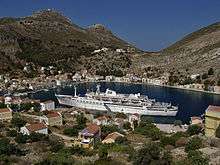
The population and the economy reached its apogee at the end of the nineteenth century with an estimated 10,000 people residing there. At that time, Kastellorizo was still the only safe harbor along the route between Makri (today's Fethiye) and Beirut.[7] Its sailing ships traded products from Anatolia (coal, timber, valonia, pine bark) against Egyptian goods (rice, sugar, coffee, tissues and yarns), and carried Anatolian cereals to Rhodes and Cyprus.[7] On the island there was also a flourishing production of charcoal (much sought after in Alexandria, where it was used for narghile).[7] The fishing industry—mainly sponges—was important too.[7]
At the dawn of the twentieth century the decay of the island's economy set in, accelerated by the decline of the Ottoman Empire and the deportation of the Anatolian Greeks in 1923. In the late 1920s the population of the island had dropped to 3,000, while about 8,000 inhabitants lived abroad, predominantly in Australia, Egypt, Greece and the U.S.[7] At that time the town had 730 inhabited houses, while 675 were already empty, and many ruined.[7]
The population, according to the 2011 census, now stands at 492, all living in the town of Megísti. The municipality also includes the islands of Ro and Strongyli, both without permanent inhabitants. Many of its emigrants live in Australia (especially in the cities of Perth and Sydney) where they are known as "Kazzies".
Culture
Kastellorizo's inhabitants had characteristic traditions, partly influenced by the Muslim tradition.[14] There were at least three types of women's dress, which used brilliantly colored fabric, and women wore necklaces, brooches, pendants and earrings made from ancient Venetian or Byzantine gold coins.[7]
The women's festive dress consisted of:
- One or more long silk blouses (ipokámiso). The most external one was closed on the front by six large filigreed gold or silver buttons. These buttons were shaped as a half-sphere depressed in the middle. From the lowest one was hung a small chain with a cross;[7]
- A pair of short pants (katofóri) whose lower part was made with good quality material quilted with gold thread;[7]
- A sleeved jacket (zepuni) made with brilliant colored silk or velvet, opened at the front;[7]
- Another long underskirt (kavadi), laced with gold thread, also opened at the front;
- A large scarf (zosma) made with three or four silk strips, quilted with gold or silver thread. It was tied very low on the sides, like a loose belt;[7]
- A large velvet coat (gunna) decorated with gold and silver lace on the hems and on the back, with *fur lapels: It was always kept open;[7]
- A woolen cap;[7]
- A quadrangular wrinkled silken shawl (mandili), decorated with relief flowers and fringed hems, coloured in white, red and deep blue. Folded diagonally, it was fixed above the cap, with its longest angle falling on the back almost to the ground, while the side edges were folded on the front or put over the shoulders;[7]
- The socks were woven with multicolored wool or silk;[7]
- The shoes were shaped like tipped slippers, and were made of velvet or silk. They were laced with gold or silver thread and shorter than the foot;[7]
The other types of dress were similar, but not so lavish and without fur decorations.[7] The girls' dress was simpler. Single and engaged girls, and married women and widows were also distinguished by dress.[7]
Religion, customs and superstitions
The engagement, which was decided by the parents, and the wedding, which lasted 15 days, occurred through prescribed and curious ceremonies, having symbolic and poetic meaning.[6] Weddings were celebrated on Sunday, in the church of Agios Konstantinos, and an announcement on the main square invited the whole city to participate. Also baptisms and funerals (with mourning women, or praeficae, and a dish with oil and wine crushed on the coffin) had well-established rituals.[6]
On December 31 and on New Year's Day, groups of children carrying small cardboard boats adorned with ribbons and small flags go around visiting houses, stores and coffee shops, singing songs with good wishes and receiving coins and wheat cakes, while the elderly exchange visits.[6] On the morning of Agios Basilios day, coming back from Liturgy, the men customarily throw a pomegranate hard against the walls of their homes, wishing for abundance and happiness for their family. The more seeds that are spread around the rooms, the more luck the family will have in the coming year.[6]
The day before the feast of Agios Elias on July 19 (the feast itself is on July 20) first the children and then the men jump into the sea, and wear their wet clothes the whole day. Those who do not want to participate are sometimes forced to do so.[6][15]
On Easter, the Liturgy of the Resurrection takes place in the open at midnight, the faithful bearing candles. As soon as the bells start ringing, the young people let off fireworks, and the people tell each other the ritual words "Christ is resurrected". Then everyone enters the church and lights his candle from the holy fire held by the priest, and then goes home to light the fire in the fireplace.[6] On Easter Monday the whole population gathers in the main square, and they remain there the whole day eating, drinking and singing. In the past single girls had to stay at home, but they were allowed to stay in the entrance, where they sang and played with swings.[6]
On May 1, at dawn, all the girls of the island, in groups, each one carrying a jar, went to get water outside of town, but they were not allowed to speak a single word during the route. This water (Amilito Neró, "water of silence") was supposed to bring good luck to the family. Everyone washed him/herself with it that day, and every utensil and wall of the house was splashed with it. When a girl became engaged, she filled a crystal carafe with it and brought it to her future mother-in-law, who gave her in return a special cake and an odd number of gold coins.[6]
When a child became seriously ill, a woman with knowledge of prayers against the evil eye was invited to her/his home. She drew signs of the cross on the body of the child with a thurible filled with embers and branches of the olive tree which had been gathered in the church on Palm Sunday, pronouncing the following words: "Christ came: then he laid down his stick and chased away the snake and the bad neighbor from our home". After this exorcism, the woman would throw the content of the thurible into a bucket filled with water, and then count the pieces of wood which did not burn. This number was said to be equal to the number of persons who were supposed to have enchanted the sick child. The enchantment of the child was sure, if the olive leaves burned with a loud crackling sound.[6]
When a man was going to emigrate, gentle, sorrowful songs were sung to him by his friends.[6]
Notable people
- Georgios Mavros, politician
Twin towns – Sister cities
Kastellorizo is twinned with:
Cinema and popular culture
Mediterraneo (1991) was filmed on the island. Kastellorizo also lends its name to David Gilmour's instrumental track "Castellorizon" from his album On an Island (2006). He stayed on the island in the early 1990s with his wife, Polly Samson, and many close friends. The music reflects the memories of the time spent there, and is a tribute to the friends who have since died.
References
- ↑ "Απογραφή Πληθυσμού - Κατοικιών 2011. ΜΟΝΙΜΟΣ Πληθυσμός" (in Greek). Hellenic Statistical Authority.
- 1 2 3 4 5 6 7 8 9 Bertarelli, 131
- ↑ Kallikratis law Greece Ministry of Interior (Greek)
- ↑ Strabo, Geographica 14.3.7
- 1 2 3 4 Stampolidis, Nicholas & others (2011). Islands off the beaten track. An archeological journey to the Greek islands of Kastellorizo, Simi, Halki, Tylos and Nisyros. Athens: Museum of Cycladic Art. p. 28.
- 1 2 3 4 5 6 7 8 9 10 11 12 Bertarelli, 133
- 1 2 3 4 5 6 7 8 9 10 11 12 13 14 15 16 17 18 19 20 21 22 Bertarelli, 132
- 1 2 3 4 Bertarelli, 134
- ↑ http://www.bluestarferries.com/en/travel-with-us/domestic-lines/timetables/piraeus-kalymnos-kos-rhodes-astypalaia-patmos-lipsi-leros-nisyros-tilos-symi-kastellorizo.html
- ↑ http://ferries-turkey.com/ferry-routes/turkey-greece/kas-meis-ferry-en.html#start
- ↑ https://e-ticket.olympicair.com/pl/A3Online/wds/FlexPricerAvailability.action;jsessionid=QkUW9l5IS4t7GVZx1q7j4KDd5w-5AfHTKGO55jOHLSJTUeYa8Cwg!384344890!-982618842
- ↑ Smith, William (1865), Dictionary of Greek and Roman geography, s.v. "Megiste".
- 1 2 "Gaza-bound ship carrying pro-Palestinian activists sets sail from Greece". Retrieved 17 July 2011.
- ↑ Gerola, Giuseppe. "Castelrosso". Enciclopedia Italiana (1931 edition). Treccani. Retrieved 21 January 2014.
- ↑ M. Hamilton, "The Pagan Element in the Names of Saints", The Annual of the British School at Athens 13 (1906–07) 348–55, pp. 353–54.
Sources
- Bertarelli, L.V. (1929). Guida d'Italia, Vol. XVII (in Italian). Milano: Consociazione Turistica Italiana.
- Hatzifotis, I.M. (1996). Kastellorizon. Athens: Topio Publications.
- Pappas, Nicholas (1994). Castellorizo: An Illustrated History of the Island and its Conquerors. Sydney: Halstead Press.
- Pappas, Nicholas (2002). Near Eastern Dreams: The French Occupation of Castellorizo 1915–1921. Sydney: Halstead Press.
- Report of SELAS Caving Club expedition to Kastellorizo.
External links
| Wikimedia Commons has media related to Kastelorizo. |
- Official website (English) (Greek)
